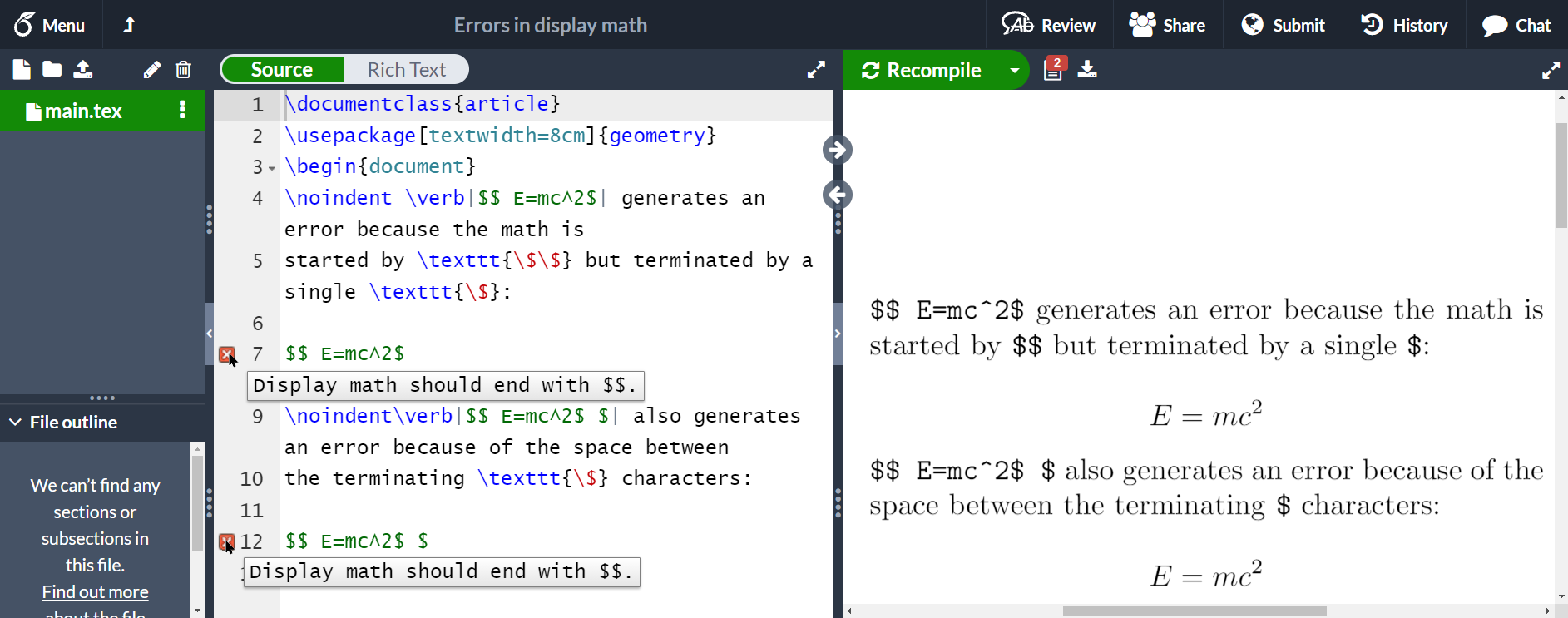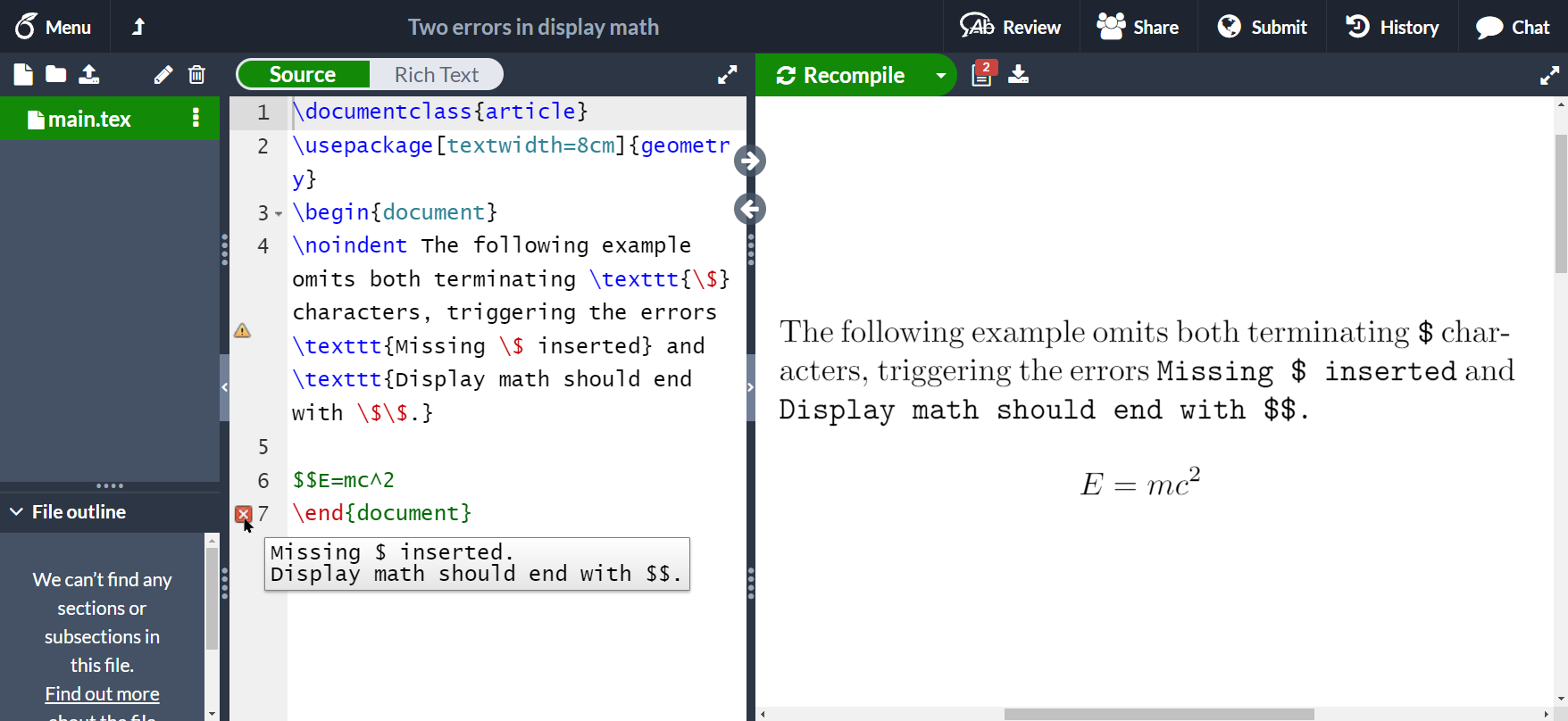Display math should end with $$
Introduction
TeX engines have two ways of typesetting mathematics:
- inline math mode where the mathematical content is contained within a paragraph, and
- display math mode where mathematical material is displayed separately, with additional space above or below it.
Traditionally, in the early days of TeX, mathematics intended to be typeset inline, typically within a paragraph, was surrounded by single $ characters: $ inline math content...$ and mathematics destined for display was surrounded by double $ characters: $$ display math content...$$.
Cause of the error Display math should end with $$
The error message Display math should end with $$ is generated by TeX engines when they try to finish typesetting some display math material but are unable to cleanly exit from display math mode due to incorrect TeX markup: as the error message indicates, the material to be typeset as display math has not been terminated with a second $$ pair.
Examples: single error
This error is demonstrated in the following examples:
\documentclass{article}
\usepackage[textwidth=8cm]{geometry}
\begin{document}
\noindent \verb|$$ E=mc^2$| generates an error because the math is
started by \texttt{\$\$} but terminated by a single \texttt{\$}:
$$ E=mc^2$
\noindent\verb|$$ E=mc^2$ $| also generates an error because of the space between
the terminating \texttt{\$} characters:
$$ E=mc^2$ $
\end{document}
Open this error-generating example in Overleaf
This example produces the following output (image edited to highlight both errors):

Example: two errors
Note: In some circumstances you may also see the related error Missing $ inserted, as the following example demonstrates by writing $$E=mc^2, which omits both terminating $ characters:
\documentclass{article}
\usepackage[textwidth=8cm]{geometry}
\begin{document}
\noindent The following example omits both terminating \texttt{\$} characters, triggering the errors \texttt{Missing \$ inserted} and \texttt{Display math should end with \$\$.}
$$E=mc^2
\end{document}
Open this error-generating example in Overleaf
This example produces the following output:

Solution
For the errors demonstrated above, the fix is straightforward—make sure you add the closing $$ at the end of your display math:
\documentclass{article}
\begin{document}
\noindent The solution is to ensure correct termination of the
display math by writing \verb|$$E=mc^2$$|:
$$E=mc^2$$
\end{document}
Open this corrected example in Overleaf
Avoid using $ characters to typeset mathematics
Nowadays, standard (accepted) best practice is to avoid using explicit $ characters to typeset mathematics and use LaTeX delimiters instead, particularly for display math:
- for display math: write
\[ display math content \]instead of$$ display math content...$$ - for inline math: write
\( inline math content \)instead of$ inline math content...$
In reality, the LaTeX delimiters \(, \), \[ and \] are single-character macros which provide a sort of “insulating wrapper” around single and double $ characters. The LaTeX definitions of those delimiters (macros) do actually contain $ characters but with additional code that runs some tests/checks. They also generate LaTeX’s error message Bad math environment delimiter. Using these delimiters (macros) has additional advantages because they can be redefined, perhaps temporarily, to achieve special effects.
Overleaf guides
- Creating a document in Overleaf
- Uploading a project
- Copying a project
- Creating a project from a template
- Using the Overleaf project menu
- Including images in Overleaf
- Exporting your work from Overleaf
- Working offline in Overleaf
- Using Track Changes in Overleaf
- Using bibliographies in Overleaf
- Sharing your work with others
- Using the History feature
- Debugging Compilation timeout errors
- How-to guides
- Guide to Overleaf’s premium features
LaTeX Basics
- Creating your first LaTeX document
- Choosing a LaTeX Compiler
- Paragraphs and new lines
- Bold, italics and underlining
- Lists
- Errors
Mathematics
- Mathematical expressions
- Subscripts and superscripts
- Brackets and Parentheses
- Matrices
- Fractions and Binomials
- Aligning equations
- Operators
- Spacing in math mode
- Integrals, sums and limits
- Display style in math mode
- List of Greek letters and math symbols
- Mathematical fonts
- Using the Symbol Palette in Overleaf
Figures and tables
- Inserting Images
- Tables
- Positioning Images and Tables
- Lists of Tables and Figures
- Drawing Diagrams Directly in LaTeX
- TikZ package
References and Citations
- Bibliography management with bibtex
- Bibliography management with natbib
- Bibliography management with biblatex
- Bibtex bibliography styles
- Natbib bibliography styles
- Natbib citation styles
- Biblatex bibliography styles
- Biblatex citation styles
Languages
- Multilingual typesetting on Overleaf using polyglossia and fontspec
- Multilingual typesetting on Overleaf using babel and fontspec
- International language support
- Quotations and quotation marks
- Arabic
- Chinese
- French
- German
- Greek
- Italian
- Japanese
- Korean
- Portuguese
- Russian
- Spanish
Document structure
- Sections and chapters
- Table of contents
- Cross referencing sections, equations and floats
- Indices
- Glossaries
- Nomenclatures
- Management in a large project
- Multi-file LaTeX projects
- Hyperlinks
Formatting
- Lengths in LaTeX
- Headers and footers
- Page numbering
- Paragraph formatting
- Line breaks and blank spaces
- Text alignment
- Page size and margins
- Single sided and double sided documents
- Multiple columns
- Counters
- Code listing
- Code Highlighting with minted
- Using colours in LaTeX
- Footnotes
- Margin notes
Fonts
Presentations
Commands
Field specific
- Theorems and proofs
- Chemistry formulae
- Feynman diagrams
- Molecular orbital diagrams
- Chess notation
- Knitting patterns
- CircuiTikz package
- Pgfplots package
- Typesetting exams in LaTeX
- Knitr
- Attribute Value Matrices
Class files
- Understanding packages and class files
- List of packages and class files
- Writing your own package
- Writing your own class